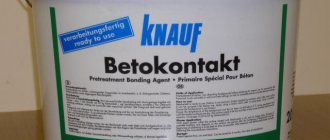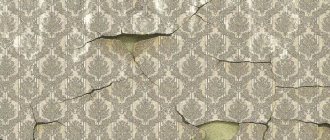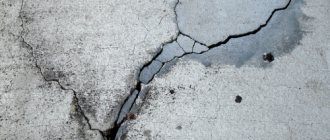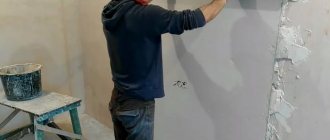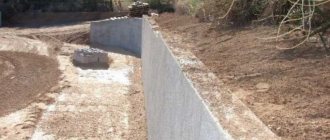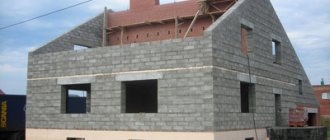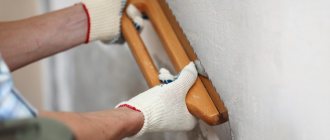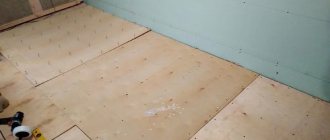Painting the room in bright or pastel colors can transform the interior and breathe new life into the apartment. In most apartment buildings, the wall structures are made of concrete. Wallpaper is not always the best design solution. Using paints, you can imitate brickwork, granite, wood, paint a wall with a picture or decorate it with patterns.
Concrete wall
How to paint concrete walls: tips and tricks
Painting concrete walls is not an easy task. It will not be possible to complete the work in a few hours. You should carefully prepare for this process: choose a roller, brush, choose paint, color scheme, protect the floor and furniture from contamination.
Practical advice from the experts:
- Do not apply paint to an unprepared surface. Small grains of sand, dust and stains will be visible on the painted surface. Unevenness can be smoothed out using sandpaper, and stains can be wiped with a wet cloth;
- Priming is an important step in painting that is very often skipped. The adhesion of paint to a reinforced concrete surface is better after applying a primer mixture;
- adding color will give the paint the desired shade. To do this, dilute a drop of color in a small amount of the coloring composition and look at the result. If you are satisfied with it, then repeat the same steps with more paint;
- dilute the paint with special means. But before that, you need to study the instructions so as not to spoil the material. Water-dispersed paints are diluted with water, and oil-based paints are diluted with drying oil;
- The correct selection of tools will eliminate uneven distribution of paint and its overuse. For hard-to-reach places, purchase brushes;
- Surfaces should be painted with strokes in one direction. Apply the second and subsequent layers after the previous one has dried. It is better to carry out the work in the daytime, when it is still light and there are no direct rays.
conclusions
When choosing a concrete surface treatment method, they are guided by the requirements for surface texture and tensile strength of the base (no more than 1.5 N/mm2). In one case, priority is given to chemical treatment, in the second – to grinding or sandblasting, etc.
It is necessary to understand that such an impact can lead to cracking of concrete, which affects adhesion to new layers and the quality of subsequent work.
| Processing method | Risk of cracking |
| Mechanical | Low to high |
| Sandblasting | Low |
| Shot blasting | Low |
| High pressure devices | Low |
| Chemical | Low |
| Thermal | Average |
If we talk about the choice of material for surface treatment, the main guideline should be the operating conditions of the structure. Liquid glass can be used as an economical waterproofing material. Polysiloxane, polyurethane, silicone, vinyl chloride paints work well on the external surfaces of concrete and reinforced concrete structures.
The video shows how to treat concrete surfaces:
Preparation
Before painting, the room needs to be prepared. At this stage, uneven surfaces should be removed, rough spots should be smoothed out, and cracks should be filled with putty.
If there are cracks
There are many reasons for the occurrence of cracks: settlement and subsidence of the soil under the building, the presence of attached buildings, errors in the design of the building, wear and tear of materials. It is not difficult to eliminate this defect if there are no serious reasons for their occurrence.
Small cracks are rubbed with mortar using a spatula. PVA glue is added to the solution. After sealing, a reinforcing tape is attached to the surface. Medium cracks are pre-cleaned from dirt and dust. The cleaned recess is moistened with water. It is then filled with solution. A metal mesh with 50*50 mm cells is placed on top of the leveled structure. Now it is possible to close the cracks with polyurethane foam.
Cracks
Without finishing
You can paint concrete wall fences without preliminary preparation with a roller, sponge or spray gun. But, before applying the paint, the wall is coated with a primer.
How to paint walls:
- Protect furniture and floors from splashes and drops;
- Tape the door handles with tape, insulate the wires from sockets and switches;
- Clean out uneven surfaces using sandpaper;
- Cover the wall with a primer mixture and do not touch it until it dries;
- When the primer mixture is absorbed and dry, you can paint the walls. It is better to apply the helmet in two layers, but only after the previous one has completely dried;
- Use a brush to paint areas that are difficult to reach with a roller.
With finishing
The set of tools for painting fences with trim consists of:
- spatulas;
- screwdriver;
- hammer;
- level and plumb;
- tape;
- grout;
- containers for primer and putty;
- brushes;
- roller
Tools
This is the minimum required set, which can be increased depending on the condition of the wall, hidden defects and the scope of work.
Old wallpaper can be removed with a spatula, the whitewash can be washed off with water, and old paint can be removed with special means. Don't forget about personal protective equipment. After removing the old coating, all defects will be visible. They must be thoroughly cleaned of dust and dirt.
After all these steps, you can proceed directly to finishing - puttying the surfaces. You can create a level base for future painting using gypsum finishing putty. This material should be used with caution. Once in the respiratory tract, gypsum settles in the lungs and leads to terrible diseases.
